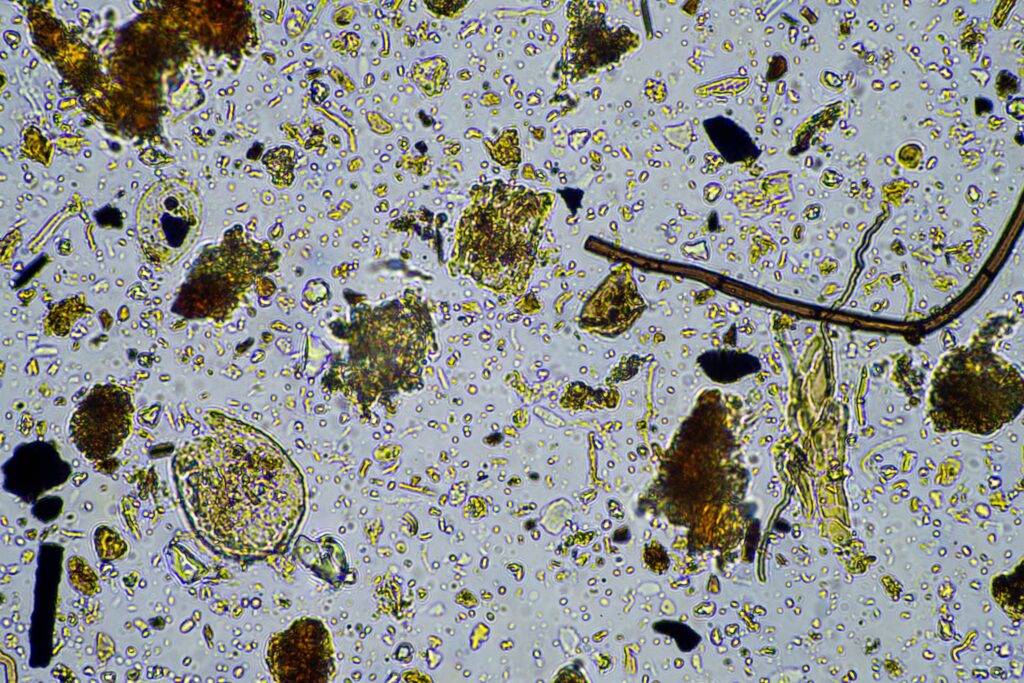When we talk about soil health, it’s tempting to think only in terms of soil chemistry. pH, nitrogen, phosphorus, and the like. But beneath all of that, and often overlooked, is a bustling, highly organised society of living organisms that quietly powers everything we do on the green. In my previous article, you’ll remember that Paul Stamets’, the eminent mycologist called the soil fungal network, Earth’s Internet. When we add in a host of other micro-organisms, this becomes the Soil Food Web, and it deserves a front-row seat in every greenkeeper’s thinking.
The soil isn’t just a substrate, it’s alive. And the quality of that life determines whether your turf merely survives or thrives.
What Is the Soil Food Web?
At its simplest, the Soil Food Web is a hierarchy of soil organisms, each feeding on or working with the other in a complex, self-regulating ecosystem. This system is what drives nutrient cycling, water regulation, disease suppression, and root development.
The main groups include:
- Bacteria – Tiny decomposers and nutrient cyclers.
- Fungi – Nutrient scavengers, soil structure builders, and plant partners.
- Protozoa – Bacterial grazers that release plant-available nutrients.
- Nematodes – Both helpful and harmful, depending on species.
- Microarthropods – Tiny shredders that help break down organic matter.
- Earthworms – The engineers, creating channels for air, water, and roots.
Each of these organisms plays a role in supporting healthy turf, not as individuals, but as part of a functioning web of life.
Turf and the Trophic Ladder
Each individual grass plant releases sugars through its roots to attract beneficial microbes. In return, those microbes mine nutrients from the soil, cycle organic matter, suppress disease, and improve soil structure. This is so important to the health of plants that they give up around 50% of the sugar they produce during photosynthesis as root exudates.
When this system is working as it should, your turf becomes more self-reliant. You reduce your dependency on synthetic fertilisers and chemicals because the biology is doing a lot of the heavy lifting. That means better playing surfaces, fewer inputs, and a greener green in every sense. A properly functioning soil food web can produce 50kg/Ha of Nitrogen per annum, just through the re-cycling the waste organic material produced by the plants. In many greens this material will simply build up as thatch, as the soil food web has been compromised so badly over the years that it can’t keep up.
This is because, when one part of the web is missing, the whole system begins to wobble. Overuse of high salt fertilisers, insecticides, fungicides, and even certain renovation techniques can wipe out microbial populations, leaving the turf reliant on ever more frequent chemical intervention. The Performance Bowling Greens Programme aims to address this and gradually reduce the disturbance of the soil as the soil’s biology recovers, but it can be a tough old slog sometimes as decades of damage need to be undone…at Nature’s pace.
Microbial Partnerships in Practice
A well-functioning soil food web allows for:
- Efficient nutrient cycling – especially nitrogen and phosphorus.
- Improved moisture retention – through microbial exudates and better structure.
- Resilience against stress – microbes buffer extremes and help plants adapt.
- Disease suppression – beneficial microbes compete with and inhibit pathogens.
- Thatched material breakdown – fungal and bacterial species decompose excess organic matter naturally.
If you’ve ever wondered why some greens seem to continually present with performance and disease problems, it’s often because the food web is broken or almost missing entirely.
Supporting the Soil Food Web through Natural Greenkeeping
Rebuilding and supporting this living soil network doesn’t have to be complicated.
Start with inoculation. Products like Sports Turf Root Developer and BioActive Thatch-Reduce are designed to reintroduce the right mix of beneficial fungi and bacteria to turf systems.
Then, feed the biology. Molturf, a molasses-derived biostimulant and Formula Green, a powerful biostimulant derived from seaweed and molasses provide a carbon-rich energy sources for microbes, encouraging their activity and facilitating rapid population growth, particularly during stress periods.
And finally, if you’re over-seeding, start right. All of my seed blends are pre-inoculated with mycorrhizal fungi, giving new plants a head start by embedding them into the web from day one.
The Big Picture
When you shift your thinking from feeding the plant to feeding the soil life that feeds the plant, everything changes. Your renovation strategy changes. Your approach to nutrition changes. Your costs change.
More importantly, the playing quality of your green improves, without the hidden ecological and financial costs of staying on the chemical treadmill.
Understanding and supporting the Soil Food Web is the first step toward resilient, high-performing turf. It’s a living system. If we want healthy greens, we need to start treating our soil like the living community it is.

